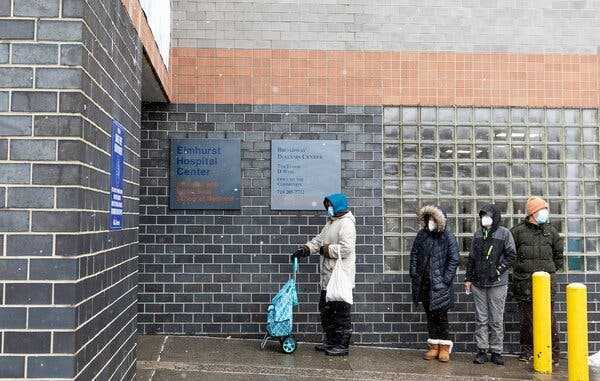The decline can be attributed to an expansion of government assistance for families and children.
-
Send any friend a story
As a subscriber, you have 10 gift articles to give each month. Anyone can read what you share.
Give this article

A line at a food distribution event in New York. Overall, household food insecurity remained level in 2021.
WASHINGTON — Food insecurity for households with children declined to its lowest rate in two decades last year, the Agriculture Department said on Wednesday, as government assistance programs continued to blunt the effect of the coronavirus on the economy.
The department’s findings were in line with data last year showing that vast expansions of government aid helped reduce hunger. But experts warned that picture was almost certain to change as pandemic-era programs expire and inflation remains high.
“The social safety net for families with children was more generous in 2021 than it has been, and better than it is now,” said Sarah Bowen, a sociology professor at North Carolina State University and an expert in food insecurity. “This shows that food insecurity is a solvable problem. We have the power to fix it.”
In a report released on Wednesday, the Agriculture Department said that about 4.6 million households with children were food insecure at some point, a rate of 12.5 percent. That was the lowest rate since at least 1998, the oldest year with comparable data.
Overall, household food insecurity remained level in 2021, the department said. About 13.5 million American households, or about 10.2 percent, were food insecure, or had difficulty providing food for all family members because of a lack of money. That was statistically unchanged from the previous two years.
But for households without children, particularly for women and seniors living alone, food insecurity increased.
Unfortunately, Ms. Bowen added, the report “also shows that it can get worse if we do nothing.”
Data released last year showed that food insecurity remained unchanged, in spite of mass unemployment and an economic downturn brought on by the pandemic. The finding was at odds with past experiences, when recessions led to a spike in hunger. Experts attributed that shift to big expansions of government aid, which continued into 2021, and additional changes to food assistance programs.
Among them were an expansion of the child tax credit, which gave most families hundreds of dollars a month; pandemic legislation, which increased benefits for the Supplemental Nutrition Assistance Program, or SNAP, and made school meals universally free; and an emergency program that reimbursed families for missed school meals.
Those changes, coupled with a recovering economy and school reopenings, particularly benefited households with children and contributed to the decline in hunger among families, experts said.
By contrast, households without children and seniors did not qualify for the expanded child tax credit or benefit from free school meals. Lauren Bauer, a researcher at the Brookings Institution who specializes in social safety net policies, said the rise in food insecurity among those groups could also be attributed to changes in household size, including losing family members or the declining propensity of older people to work.
Food insecurity also declined for households with Black Americans, to 19.8 percent last year from 21.7 percent in 2020. The gap between Black and white households also narrowed to 12.8 percent from 14.6 percent in 2020, but remained wider than the prepandemic figure of 11.2 percent in 2019.
Experts said that the portrait of hunger in the United States would change this year given that many of the assistance programs had lapsed.
“Even though we have evidence that these policies worked, we haven’t managed to preserve most of them,” Professor Bowen said.
“I’m worried that 2022 is going to be a really hard year for lots of families, and that there isn’t the same sense of urgency that there was two years ago,” she added.
Source: nytimes.com



